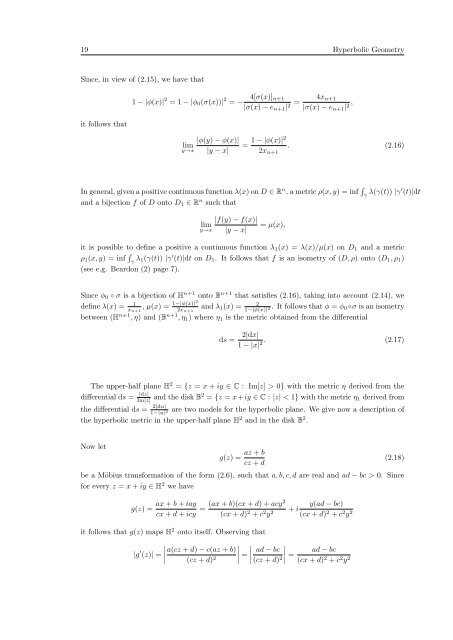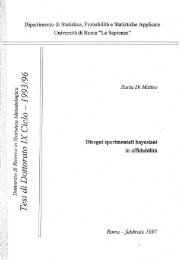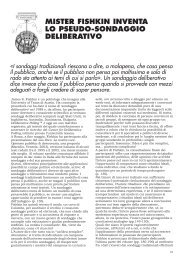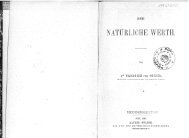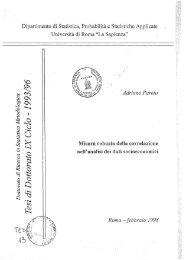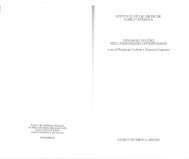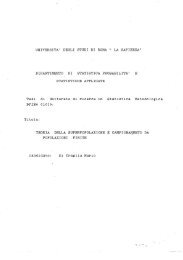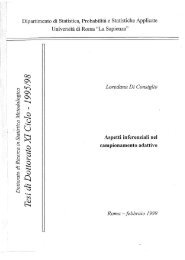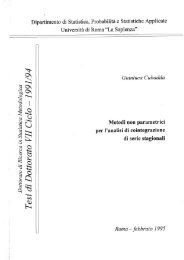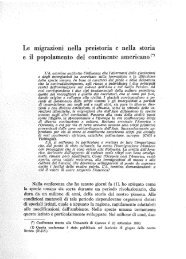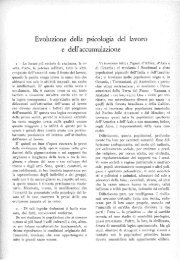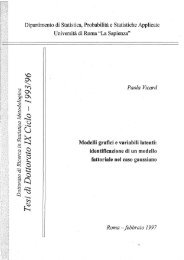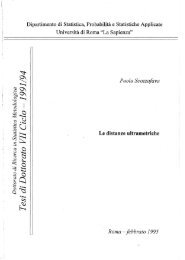Random Processes in Hyperbolic Spaces Hyperbolic Brownian ...
Random Processes in Hyperbolic Spaces Hyperbolic Brownian ...
Random Processes in Hyperbolic Spaces Hyperbolic Brownian ...
Create successful ePaper yourself
Turn your PDF publications into a flip-book with our unique Google optimized e-Paper software.
19 <strong>Hyperbolic</strong> Geometry<br />
S<strong>in</strong>ce, <strong>in</strong> view of (2.15), we have that<br />
it follows that<br />
1 − |φ(x)| 2 = 1 − |φ0(σ(x))| 2 = − 4[σ(x)]n+1 4xn+1<br />
=<br />
,<br />
|σ(x) − en+1|<br />
2 |σ(x) − en+1|<br />
2<br />
|φ(y) − φ(x)|<br />
lim<br />
=<br />
y→x |y − x|<br />
1 − |φ(x)|2<br />
2xn+1<br />
. (2.16)<br />
In general, given a positive cont<strong>in</strong>uous function λ(x) on D ∈ Rn , a metric ρ(x, y) = <strong>in</strong>f <br />
γ λ(γ(t)) |γ′ (t)|dt<br />
and a bijection f of D onto D1 ∈ Rn such that<br />
|f(y) − f(x)|<br />
lim<br />
= µ(x),<br />
y→x |y − x|<br />
it is possible to def<strong>in</strong>e a positive a cont<strong>in</strong>uous function λ1(x) = λ(x)/µ(x) on D1 and a metric<br />
ρ1(x, y) = <strong>in</strong>f <br />
γ λ1(γ(t)) |γ ′ (t)|dt on D1. It follows that f is an isometry of (D, ρ) onto (D1, ρ1)<br />
(see e.g. Beardon (2) page 7).<br />
S<strong>in</strong>ce φ0 ◦ σ is a bijection of H n+1 onto B n+1 that satisfies (2.16), tak<strong>in</strong>g <strong>in</strong>to account (2.14), we<br />
def<strong>in</strong>e λ(x) = 1<br />
1−|φ(x)|2<br />
2<br />
, µ(x) = and λ1(x) =<br />
xn+1 2xn+1<br />
1−|φ(x)| 2 . It follows that φ = φ0◦σ is an isometry<br />
between (H n+1 , η) and (B n+1 , η1) where η1 is the metric obta<strong>in</strong>ed from the differential<br />
ds = 2|dx|<br />
. (2.17)<br />
1 − |x| 2<br />
The upper-half plane H 2 = {z = x + iy ∈ C : Im[z] > 0} with the metric η derived from the<br />
differential ds = |dz|<br />
Im[z] and the disk B2 = {z = x+iy ∈ C : |z| < 1} with the metric η1 derived from<br />
the differential ds = 2|du|<br />
1−|u| 2 are two models for the hyperbolic plane. We give now a description of<br />
the hyperbolic metric <strong>in</strong> the upper-half plane H 2 and <strong>in</strong> the disk B 2 .<br />
Now let<br />
g(z) =<br />
az + b<br />
cz + d<br />
(2.18)<br />
be a Möbius transformation of the form (2.6), such that a, b, c, d are real and ad − bc > 0. S<strong>in</strong>ce<br />
for every z = x + iy ∈ H 2 we have<br />
g(z) =<br />
ax + b + iay<br />
cx + d + icy<br />
= (ax + b)(cx + d) + acy2<br />
(cx + d) 2 + c 2 y 2<br />
it follows that g(z) maps H 2 onto itself. Observ<strong>in</strong>g that<br />
y(ad − bc)<br />
+ i<br />
(cx + d) 2 + c2y2 |g ′ <br />
<br />
(z)| = <br />
a(cz + d) − c(az + b)<br />
(cz + d) 2<br />
<br />
<br />
<br />
=<br />
<br />
<br />
<br />
ad − bc<br />
(cz<br />
+ d) 2<br />
<br />
<br />
<br />
=<br />
ad − bc<br />
(cx + d) 2 + c2y2


